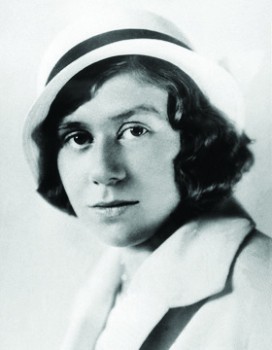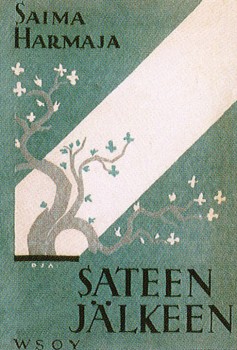Far from the madding crowd
21 February 2013 | Articles, Non-fiction

Saima Harmaja (1913–1937). Photo: WSOY
‘I don’t belong to the crowd,’ the young Saima Harmaja wrote in her diary in 1933. Her work as a poet was for her a vocation that superseded everything else. In her diaries she often speaks as a sociable young woman, with a delicious sense of humour, but her best poems seriously explore love, and death which cast its shadow over her. A selection of her poems – the best of which have made her a Finnish classic – is now published in English for the first time
In her diary the young poet claimed: ‘I think I would die if I could not write.’ What Harmaja shared with the poets of the early part of the twentieth century who influenced her was the private and personally experienced nature of poetry itself, rather than the realisation of any current aesthetic programme.
Harmaja is one of those poets whose works have passed through the hands of readers from decade to decade. She is also a prototype of the poet of her generation: gifts that led to the expectation of a brilliant career, a life that was brought to a tragic end by tuberculosis, leaving just five years of work as a poet.
Harmaja was a contemporary of two movements in Finnish poetic modernism, Tulenkantajat (‘The Firebearers’) and Kiila (‘The Wedge’). Tulenkantajat wanted to open the doors to Europe, and were fascinated by expressionistic literature and cosmopolitanism. Kiila, on the other hand, represented left-wing literature with a social orientation.
Harmaja was not a modernist or a politically oriented poet. She did not belong to any school of thought, even though she received her poetic training in the circle of the Nuoren Voiman Liitto (‘Young Power Society’). Harmaja’s own role models were Aleksis Kivi (1834–1872), Uuno Kailas (1901–1933), Katri Vala (1901–1944), Lauri Viljanen (1900–984) and Mika Waltari (1908–1979). She carefully weighed the technical resources of her poetry and decided on metrical form as her mode of expression. Harmaja also translated into Finnish such skilful modifiers of metrical verse as Gustaf Fröding and Heinrich Heine.
Among the modernists and innovators of the period, like the free verse poet Katri Vala and those who employed rhyme and metre with great skill – Kailas, Aaro Hellaakoski (1893–1952) and Kaarlo Sarkia (1902–1945) – Harmaja did not occupy a prominent place in the canon established by literary historians. Yet her poems, many of which portray her personal story and life-and-death struggle, have drawn the attention of generation after generation of readers. In her published diaries, which illuminate the core of his poetry, she has been especially popular among younger female readers.
Harmaja encountered two serious blows when she had already fallen fatally ill. Her first love, her classmate, drew back from the relationship. Her dear elder sister Outi unexpectedly died in childbirth, and because of her illness, Harmaja was not even allowed to touch her little niece. The poem ‘Outi Talvitie. In memoriam’ was written after her sister’s death in 1936.
In her four collections Huhtikuu (‘April’, 1932), Sateen jälkeen (‘After the rain‘, 1935), Hunnutettu (‘Veiled’, 1936) and the posthumous Kaukainen maa (‘Distant land’, 1937) Harmaja managed to secure a place in the hearts of her readers. In recent years her poetry has also been discovered by musicians and poets. Her verses of longing and Weltschmerz, which seem almost expressly written to be set to music, inspired Tapani Suonto’s setting of the poem ‘My wings are broken’ (Huhtikuu), which is often sung at religious services. Finnish folk, gospel, jazz and pop groups like Ajopuut, Mustarastas and Uinuva, have composed music for many of Harmaja’s poems. Uinuva’s new album will appear in 2013, and all the songs on it are settings of texts by her. The poem ‘Rannalla’,’On the shore’, has been set several times:
Ihanat vaaleat pilvet
liukuvat taivaalla.
Hiljaa ja lumoavasti
laulaa ulappa.
Aaltojen hyväilyistä
hiekka on väsynyt.
Tulisit aivan hiljaa,
tulisit juuri nyt –
The wonderful pale clouds
cross the sky like wings.
Quiet and enchanting
the open water sings.
The sand has grown weary
of the waves’ caressing play.
Now come in perfect quiet,
now come here, right away…
On his blog the poet Esa Mäkijärvi (born 1984) profiles Harmaja’s importance as a poet who reflected on life and individual literary identity. Mäkijärvi, whose own most recent book is called Kaukainen maa (‘Distant land’, 2011), perceptively summarises her achievement: ‘Harmaja is a good role model for young poets like us, because in spite of her own young age and the fury that was an inherent part of it, she was able to produce a very well balanced œuvre…. I would hope that we all might be able to live each day of our lives with equal dedication.’
In addition to producing skilfully wrought though fairly conventional nature and love poetry, Harmaja also could also write with a sense of humour. But her best poems are about death. ‘On maa’ (‘There is a land’), a poem from her last, posthumously published collection, movingly unites death with literary tradition. ‘On maa’ is like a re-writing of the famous poem about death by the Finland-Swedish modernist Edith Södergran (who also died from tuberculosis, at the age of 31), ‘Landet som icke är’ (‘The land that is not’, from the posthumous collection with the same title, 1925).
Where Södergran’s expressionist poem presents the paradox of a land that does not exist, Harmaja writes about a land that does. Södergran’s poem features a cosmic beloved whom the author addresses; Harmaja’s poem speaks of a suffering human being who is looking for her loved ones and the consolation of death on the other side. The speaker of the poem finds a perspective that goes beyond all banalities and approaches the mystery of existence as a promise of being together.
(- – – – )
There is a land to where
all paths vanish, then cease.
Those there do not see the reflection
That lights us a darkened ways.
Into the eyes of Being they gaze.
It is the land of Peace.
Translated by David McDuff
![]()
 ‘Tulisit aivan hiljaa…’ (‘Now come in perfect quiet…’), an exhibition of the life and work of Saima Harmaja, will open at the National Library in Helsinki on 27 February and last until 29 May. It contains first editions, photographs and letters, and a series of poetry readings and concerts will take place in the Library from early March onwards. The exhibition is a collaboration between the Library and the Saima Harmaja society (texts in Finnish only). Photographs of Saima, her family and friends
‘Tulisit aivan hiljaa…’ (‘Now come in perfect quiet…’), an exhibition of the life and work of Saima Harmaja, will open at the National Library in Helsinki on 27 February and last until 29 May. It contains first editions, photographs and letters, and a series of poetry readings and concerts will take place in the Library from early March onwards. The exhibition is a collaboration between the Library and the Saima Harmaja society (texts in Finnish only). Photographs of Saima, her family and friends
Tags: biography, classics, literary history, poetry
No comments for this entry yet
Trackbacks/Pingbacks:

26 May 2016 on 5:09 pm
[…] is one of Harmaja‘s last poems. I fear I’m seeing through a glass darkly: I have no conception of what it […]